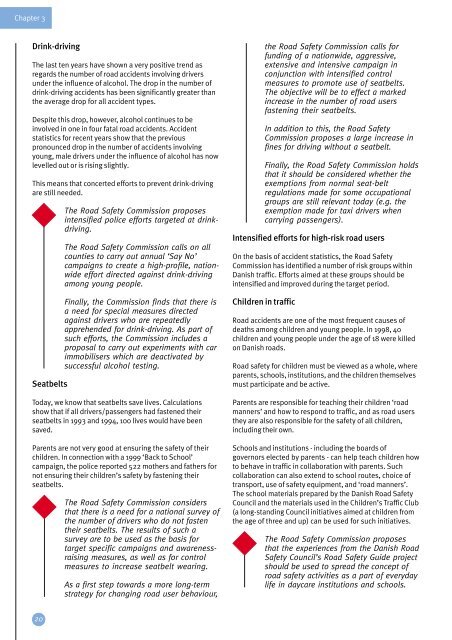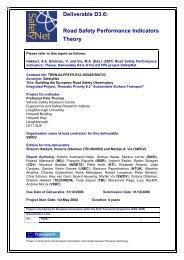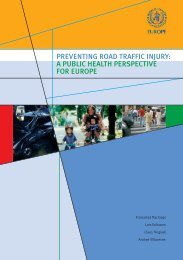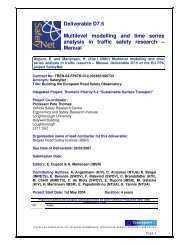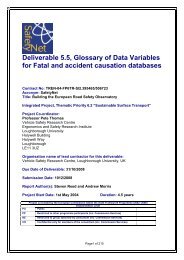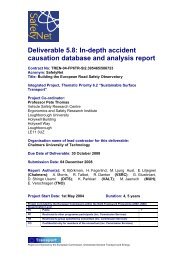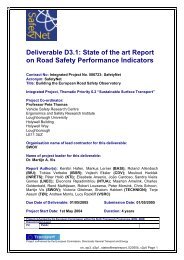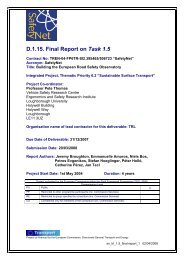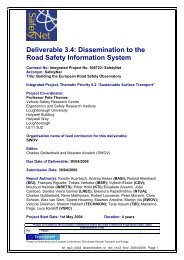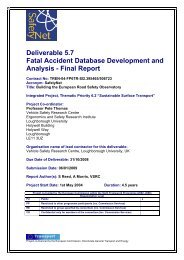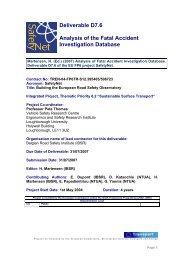Every Accident is One Too Many Every Accident is One ... - UNECE
Every Accident is One Too Many Every Accident is One ... - UNECE
Every Accident is One Too Many Every Accident is One ... - UNECE
You also want an ePaper? Increase the reach of your titles
YUMPU automatically turns print PDFs into web optimized ePapers that Google loves.
Chapter 3<br />
Drink-driving<br />
The last ten years have shown a very positive trend as<br />
regards the number of road accidents involving drivers<br />
under the influence of alcohol. The drop in the number of<br />
drink-driving accidents has been significantly greater than<br />
the average drop for all accident types.<br />
Despite th<strong>is</strong> drop, however, alcohol continues to be<br />
involved in one in four fatal road accidents. <strong>Accident</strong><br />
stat<strong>is</strong>tics for recent years show that the previous<br />
pronounced drop in the number of accidents involving<br />
young, male drivers under the influence of alcohol has now<br />
levelled out or <strong>is</strong> r<strong>is</strong>ing slightly.<br />
Th<strong>is</strong> means that concerted efforts to prevent drink-driving<br />
are still needed.<br />
Seatbelts<br />
The Road Safety Comm<strong>is</strong>sion proposes<br />
intensified police efforts targeted at drinkdriving.<br />
The Road Safety Comm<strong>is</strong>sion calls on all<br />
counties to carry out annual ‘Say No’<br />
campaigns to create a high-profile, nationwide<br />
effort directed against drink-driving<br />
among young people.<br />
Finally, the Comm<strong>is</strong>sion finds that there <strong>is</strong><br />
a need for special measures directed<br />
against drivers who are repeatedly<br />
apprehended for drink-driving. As part of<br />
such efforts, the Comm<strong>is</strong>sion includes a<br />
proposal to carry out experiments with car<br />
immobil<strong>is</strong>ers which are deactivated by<br />
successful alcohol testing.<br />
Today, we know that seatbelts save lives. Calculations<br />
show that if all drivers/passengers had fastened their<br />
seatbelts in 1993 and 1994, 100 lives would have been<br />
saved.<br />
Parents are not very good at ensuring the safety of their<br />
children. In connection with a 1999 ‘Back to School’<br />
campaign, the police reported 522 mothers and fathers for<br />
not ensuring their children’s safety by fastening their<br />
seatbelts.<br />
The Road Safety Comm<strong>is</strong>sion considers<br />
that there <strong>is</strong> a need for a national survey of<br />
the number of drivers who do not fasten<br />
their seatbelts. The results of such a<br />
survey are to be used as the bas<strong>is</strong> for<br />
target specific campaigns and awarenessra<strong>is</strong>ing<br />
measures, as well as for control<br />
measures to increase seatbelt wearing.<br />
As a first step towards a more long-term<br />
strategy for changing road user behaviour,<br />
the Road Safety Comm<strong>is</strong>sion calls for<br />
funding of a nationwide, aggressive,<br />
extensive and intensive campaign in<br />
conjunction with intensified control<br />
measures to promote use of seatbelts.<br />
The objective will be to effect a marked<br />
increase in the number of road users<br />
fastening their seatbelts.<br />
In addition to th<strong>is</strong>, the Road Safety<br />
Comm<strong>is</strong>sion proposes a large increase in<br />
fines for driving without a seatbelt.<br />
Finally, the Road Safety Comm<strong>is</strong>sion holds<br />
that it should be considered whether the<br />
exemptions from normal seat-belt<br />
regulations made for some occupational<br />
groups are still relevant today (e.g. the<br />
exemption made for taxi drivers when<br />
carrying passengers).<br />
Intensified efforts for high-r<strong>is</strong>k road users<br />
On the bas<strong>is</strong> of accident stat<strong>is</strong>tics, the Road Safety<br />
Comm<strong>is</strong>sion has identified a number of r<strong>is</strong>k groups within<br />
Dan<strong>is</strong>h traffic. Efforts aimed at these groups should be<br />
intensified and improved during the target period.<br />
Children in traffic<br />
Road accidents are one of the most frequent causes of<br />
deaths among children and young people. In 1998, 40<br />
children and young people under the age of 18 were killed<br />
on Dan<strong>is</strong>h roads.<br />
Road safety for children must be viewed as a whole, where<br />
parents, schools, institutions, and the children themselves<br />
must participate and be active.<br />
Parents are responsible for teaching their children ‘road<br />
manners’ and how to respond to traffic, and as road users<br />
they are also responsible for the safety of all children,<br />
including their own.<br />
Schools and institutions - including the boards of<br />
governors elected by parents - can help teach children how<br />
to behave in traffic in collaboration with parents. Such<br />
collaboration can also extend to school routes, choice of<br />
transport, use of safety equipment, and ‘road manners’.<br />
The school materials prepared by the Dan<strong>is</strong>h Road Safety<br />
Council and the materials used in the Children’s Traffic Club<br />
(a long-standing Council initiatives aimed at children from<br />
the age of three and up) can be used for such initiatives.<br />
The Road Safety Comm<strong>is</strong>sion proposes<br />
that the experiences from the Dan<strong>is</strong>h Road<br />
Safety Council’s Road Safety Guide project<br />
should be used to spread the concept of<br />
road safety activities as a part of everyday<br />
life in daycare institutions and schools.<br />
20


